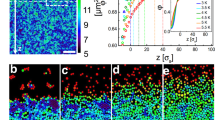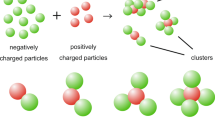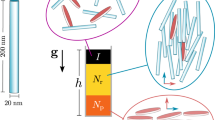Abstract
The structure of, and transitions between, liquids, crystals and glasses have commonly been studied with the hard-sphere model1,2,3,4,5, in which the atoms are modelled as spheres that interact only through an infinite repulsion on contact. Suspensions of uniform colloidal polymer particles are good approximations to hard spheres6,7,8,9,10,11, and so provide an experimental model system for investigating hard-sphere phases. They display a crystallization transition driven by entropy alone. Because the particles are much larger than atoms, and the crystals are weakly bound, gravity plays a significant role in the formation and structure of these colloidal crystals. Here we report the results of microgravity experiments performed on the Space Shuttle Columbia to elucidate the effects of gravity on colloidal crystallization. Whereas in normal gravity colloidal crystals grown just above the volume fraction at melting show a mixture of random stacking of hexagonally close-packed planes (r.h.c.p.) and face-centred cubic (f.c.c.) packing if allowed time to settle7,8, those in microgravity exhibit the r.h.c.p. structure alone, suggesting that the f.c.c. component may be induced by gravity-induced stresses. We also see dendritic growth instabilities that are not evident in normal gravity, presumably because they are disrupted by shear-induced stresses as the crystals settle under gravity. Finally, glassy samples at high volume fraction which fail to crystallize after more than a year on Earth crystallize fully in less than two weeks in microgravity. Clearly gravity masks or alters some of the intrinsic aspects of colloidal crystallization.
This is a preview of subscription content, access via your institution
Access options
Subscribe to this journal
Receive 51 print issues and online access
$199.00 per year
only $3.90 per issue
Buy this article
- Purchase on Springer Link
- Instant access to full article PDF
Prices may be subject to local taxes which are calculated during checkout




Similar content being viewed by others
References
Wood, W. W. & Jacobsen, J. D. Preliminary results from recalculation of the Monte Carlo equation of state of hard spheres. J. Chem. Phys. 27, 1207–1208 (1957).
Adler, B. J. & Wainwright, T. E. Phase transition for a hard sphere system. J. Chem. Phys. 27, 208–1209 (1957).
Hoover, W. G. & Ree, F. H. J. Melting transition and communal entropy for hard spheres. Chem. Phys. 49, 3609–3617 (1968).
Alder, B. J., Hoover, W. G. & Young, D. A. Studies in molecular dynamic V. High density equation of state and entropy for hard disks and spheres. J. Chem. Phys. 49, 3688–3696 (1968).
Woodcock, L. V. Glass transition and the hard sphere model. J. Chem. Soc. Faraday II 72, 1667–1672 (1976).
Pusey, P. N. & van Megen, W. Phase behavior of concentrated suspensions of nearly hard colloidal spheres. Nature 320, 340–342 (1986).
Pusey, P. N., van Megen, W., Bartlett, W. P. & Ackerson, B. J. Structure of crystals of hard colloidal spheres. Phys. Rev. Lett. 63, 2753–2756 (1989).
Pusey, P. N. in Liquids, Freezing and the Glass Transition Course 10, Colloidal Suspensions (eds Hansen, J. P., Leveesque, D. & Zinn-Justin, J.) 763–942 (Elsevier, Amsterdam, (1991)).
de Kruif, C. G., Jansen, J. W. & Vrij, A. in Physics of Complex and Supramolecular Fluids (eds Safran, S. A. & Clark, N. A.) 315–343 (Wiley-Interscience, New York, (1987)).
Smitz, C., Briels, W. J., Dhont, J. K. G. & Lekkerkerker, H. N. W. Influence of stabilizing coating on the rate of crystallization of colloidal systems. Prog. Colloid Polym. Sci. 78, 287–292 (1989).
Phan, S. E. et al. Phase transition, equation of state, and limiting shear viscosities of hard sphere dispersions. Phys. Rev. E 54, 6633–6645 (1996).
Biben, T., Ohnesorge, R. & Lowen, H. Crystallization in sedimentation profiles of hard spheres. Europhys. Lett. 28, 665–670 (1994).
Frenkel, D. & Ladd, A. J. C. New Monte Carlo method to compute the free energy of arbitrary solids. Applciation to the fcc and hcp phases of hard spheres. J. Chem. Phys. 81, 3188–3193 (1984).
Woodcock, L. V. Entropy difference between the face-centred cubic and hexagonal close-packed crystal structures. Nature 385, 141–143 (1997).
Wilson, A. J. C. Imperfections in the structure of a cobalt II. Mathematical treatment of the proposed structure. Proc. R. Soc. Lond. A 180, 277–285 (1942).
Gast, A. & Monovoukas, Y. Anew growth instability in colloidal crystallization. Nature 351, 553–557 (1991).
Schatzel, K. & Ackerson, B. J. Observation of density fluctuations during crystallization. Phys. Rev. Lett. 68, 337–340 (1992).
Ackerson, B. J. & Schatzel, K. Classical growth of hard-sphere colloidal crystals. Phys. Rev. B 52, 6448–6460 (1995).
Russel, W. B., Chaikin, P. M., Zhu, J., Meyer, W. V. & Rogers, R. Dendritic growth of hard sphere crystals. Langmuir (in the press).
Langer, J. S. Instabilities and pattern formation in crystal growth. Rev. Mod. Phys. 52, 1–28 (1980).
Frenkel, D. & Ladd, A. J. C. Elastic constants of hard sphere crystals. Phys. Rev. Lett. 59, 1169 (1987).
van Megen, W. & Underwood, S. M. Glass transition in colloidal hard spheres: mode coupling theory analysis. Phys. Rev. Lett. 70, 2766–2769 (1993).
van Megen, W. & Underwood, S. M. Glass transition in colloidal hard spheres: measurement and mode coupling theory analysis of the coherent intermediate scattering functions. Phys. Rev. E 49, 4206–4220 (1994).
Rintoul, M. D. & Torquato, S. Computer simualtions of dense hard-sphere systems. Chem. Phys. 105, 9258–9265 (1996).
Ononda, G. Y. & Liniger, E. G. Random loose packings of uniform spheres and the dilatancy onset. Phys. Rev. Lett. 64, 2727–2730 (1990).
Acknowledgements
We thank B. J. Ackerson, P. N. Pusey and D. A. Huse for discussions. This work was supported by the NASA Microgravity Sciences program.
Author information
Authors and Affiliations
Consortia
Corresponding author
Rights and permissions
About this article
Cite this article
Zhu, J., Li, M., Rogers, R. et al. Crystallization of hard-sphere colloids in microgravity. Nature 387, 883–885 (1997). https://doi.org/10.1038/43141
Received:
Accepted:
Issue Date:
DOI: https://doi.org/10.1038/43141
This article is cited by
-
Unified explanation for self-assembly of polymer-brush-modified nanoparticles in ionic liquids
Polymer Journal (2023)
-
Dislocation interactions during plastic relaxation of epitaxial colloidal crystals
Nature Communications (2023)
-
Clustering of charged colloidal particles in the microgravity environment of space
npj Microgravity (2023)
-
A review on photonic crystal materials in food detection
European Food Research and Technology (2023)
-
Active matter in space
npj Microgravity (2022)
Comments
By submitting a comment you agree to abide by our Terms and Community Guidelines. If you find something abusive or that does not comply with our terms or guidelines please flag it as inappropriate.



